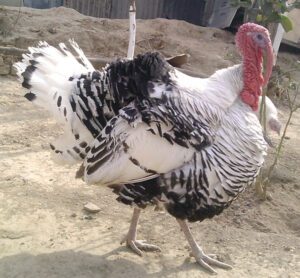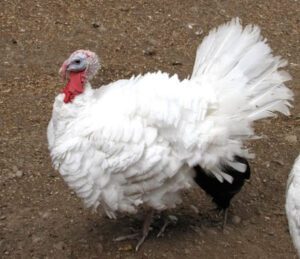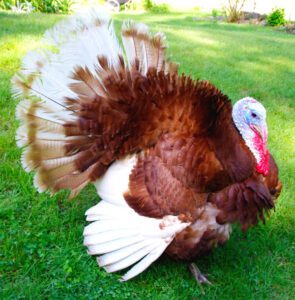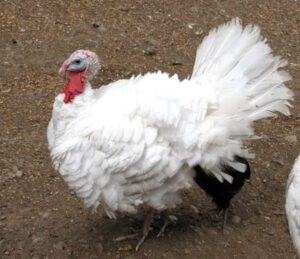The White Holland turkey is a very old variety of domestic turkey which was originated from United States. It is known for it’s white plumage, and it was most important white-feathered variety throughout most of American history.
Today it is one of the rarest and most difficult to authenticate varieties despite the illustrious past. During the first half of the 1900s, the White Holland turkey was the only commercial white variety.
Connection of the White Holland turkey to the Netherlands is unsubstantiated, originated from crosses of white European turkeys imported to North America and crossed with the native birds.
The variety was first recognized by the American Poultry Association in 1874. And today it is considered as a heritage turkey breed.
It was crossed with the Broad Breasted Bronze in the 1950s for creating the Broad Breasted White, which is the most common turkey breed throughout the world today. The White Holland turkey breed is also the base for creating the rare Beltsville Small White turkey breed.
Currently the White Holland turkey is a rare breed and listed as ‘threatened‘ by The Livestock Conservancy in the United States. Read some more information about this turkey breed below.
History And Origins of White Holland Turkey
White Holland Turkeys are very old birds and they have a rich history that dates back to the early days of American poultry farming. Although the exact origins of the breed are somewhat unclear, it is believed that they were developed in the United States in the early 1800s.
The breed’s name, “Holland,” is thought to be a reference to the Dutch settlers who played a crucial role in the early development of American agriculture.
These turkeys are descendants of European breeds, particularly English turkeys that were brought to America by early settlers.
Over time, selective breeding was used to refine the breed, resulting in the distinctive all-white appearance that White Holland Turkeys are known for today.
Characteristics
The White Holland turkey birds are beautiful birds which are often confused with the Broad Breasted White turkeys. But the Broad Breasted White turkeys are larger in size than these birds. The White Holland turkeys have smaller sized breast and relatively longer legs. They are completely white in coloration.
Their feathers are snow white and the head is red to bluish. Their beard is black and the beak is pink to horn colored. Their throat and wattles are pinkish-white. Shanks and toes of the White Holland turkey are pinkish-white, and the eyes are brown. Average live body weight of the mature tom is around 16.33 kg. And the mature hens on average weight around 9 kg.[1].

Housing
White Holland Turkeys require spacious and well-ventilated housing system that protect them from extreme weather conditions. Ensure that the house is spacious enough and able to provide ample space for the birds to move around comfortably while ensuring their safety from predators.
Arrange adequate nesting areas for egg-laying hens. And provide roosting spaces to promote their natural behaviors. Proper sanitation and regular cleaning are also vital to maintain a healthy environment for White Holland Turkeys. So, try to clean their house on a regular basis.
Feeding
Feeding the birds is a very important part of their care. These birds have specific dietary requirements. And you should fulfill their dietary requirements to ensure their good health and growth.
A well-balanced diet for White Holland Turkeys typically consists of high-quality turkey pellets or feed specially formulated for their nutritional needs. And along with food, it is also important to provide access to fresh, clean water at all times.
Breeding
Breeding White Holland Turkeys is very easy and simple. Keep good ratio of toms and hens in your flock, and your birds will do the rest. Generally, one male bird is enough for every six to eight females.
Caring
Caring for White Holland Turkeys is relatively easy and simple, but it requires attention to their specific needs to ensure their happy life and good health. Their caring tasks include providing them with secure and comfortable housing system, providing good quality and nutritious food, monitoring their health on a regular basis etc.
Uses
This turkey breed is raised mainly for meat production. But they are also good for producing eggs. Although they are raised for egg purpose rarely.
Special Notes
The White Holland turkeys are known for their hardiness. Today they are a rare variety of domestic turkey. They are occasionally seen at poultry shows. Although these animals are smaller in size but they are more desirable than some of the other larger turkey breeds.
They are mostly docile in temperament, although some birds can be aggressive. The hens lay large sized eggs, and their eggs are pale cream to medium brown in color with spotting. However, review full breed profile of this breed in the chart below.
| Breed Name | White Holland |
| Other Names | British White |
| Breed Purpose | Meat |
| Special Notes | Known for their hardiness, pretty rare today, occasionally seen at poultry shows, smaller in size but are more desirable than some of the other larger turkey breeds, docile temperament, but some birds can be aggressive, large eggs, the eggs are pale cream to medium brown in color with spotting |
| Breed Size | Medium |
| Tom | Around 16.33 kg |
| Hen | Around 9 kg |
| Varieties | White |
| Climate Tolerance | Almost all climates |
| Color | White |
| Rarity | Rare |
| Country/Place of Origin | United States |






